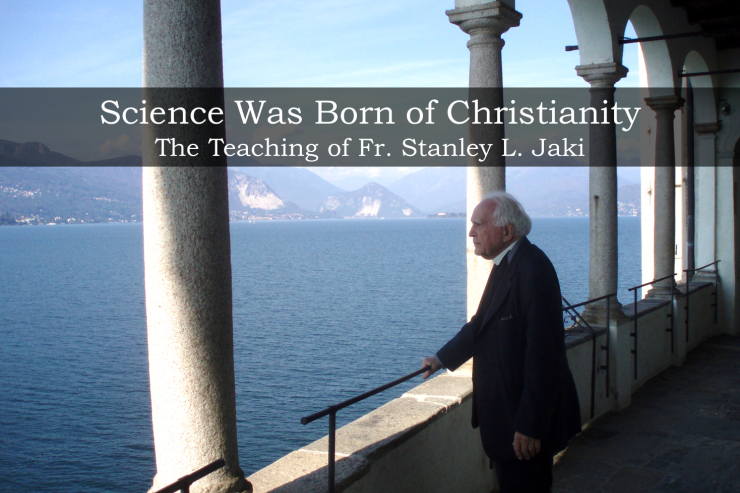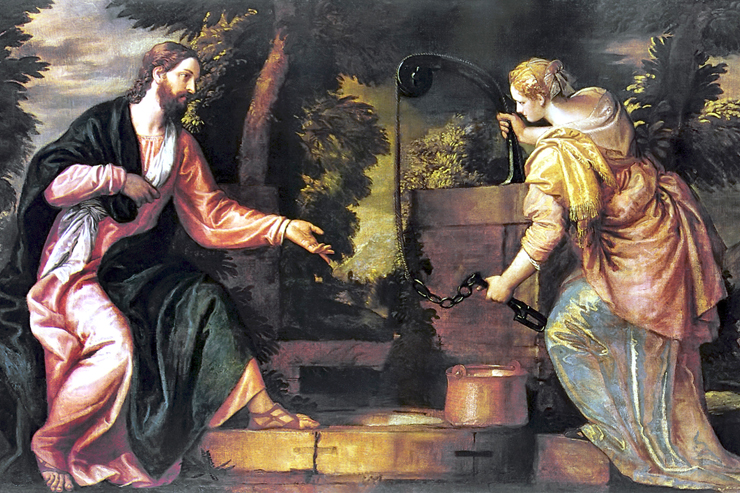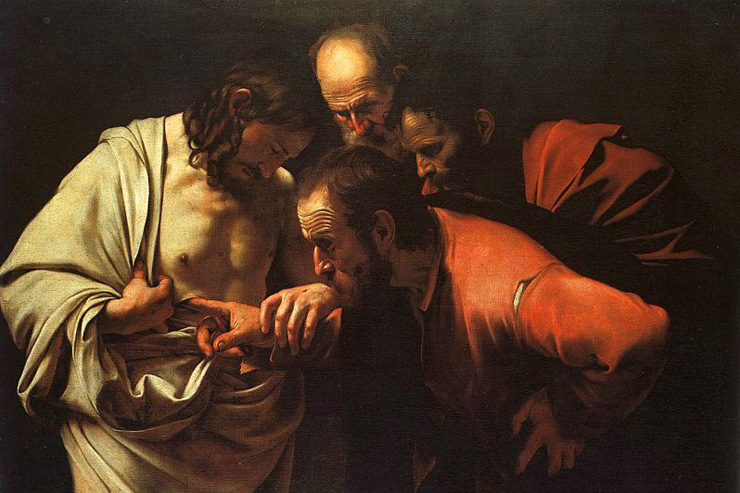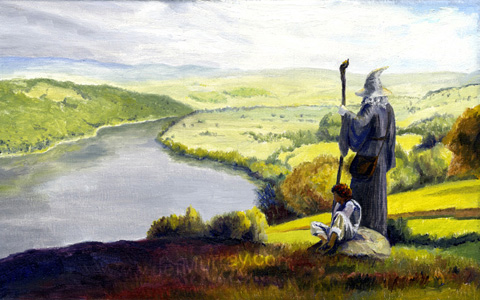This Teaching Series
Holy Tuesday, April 7, marked six years since Fr. Stanley L. Jaki died in Madrid in 2009. Toward the end of his life, Fr. Stanley L. Jaki asked himself, “What is the point to work hard on a topic, though only to see in the end that what one tried to transmit on the basis of decades of hard work runs like water off a duck’s back?”[1] These words are in his 2009 addendum, “Three More Years,” to his 2002 autobiography titled A Mind’s Matter: An Intellectual Autobiography. However in 2015, it does not seem that Jaki’s work has slipped away at all. The appreciation for his brilliance has continued to gain traction.
Two of Jaki’s most important teachings were 1) the divide between theology and science and 2) the claim that science was born of Christianity. Plenty of people will easily agree that science and faith occupy separate domains of knowledge, but the claim that science was born of Christian faith will likely evoke suspicion or denial especially if the facts for the claim are not presented. These facts and these two teachings of Fr. Jaki’s are relevant for those navigating a secular society where people think science removes the need for faith or go so far as to elevate science to, as Jaki put it, omniscience.
I have been learning and defending these teachings of Jaki’s ever since I first read his book, The Savior of Science in 2010. I find Jaki’s clear definition of science and his exhaustive accounting of the historical facts of the Christian birth of science compelling (even to atheists). Hence, I work to communicate Fr. Jaki’s teaching because it is our Catholic heritage. I seek to inspire Catholic leaders in science.
In the weeks to follow and in commemoration of Fr. Jaki, I will present a sifted compilation of the historical facts of his research, taken from my book on the subject which itself is a summary of Jaki’s much longer works. I hope you will join me in sharing the work of this physicist, historian, theologian, and holy priest with the next generation. This series will proceed as follows:
- Fr. Stanley Jaki’s Definition of Science
- The Stillbirths of Science in Ancient Cultures
- The Radical Scientific View of Biblical Cultures
- The Christian Middle Ages and the Greek Scientific Corpus
- Fr. Jean Buridan’s Impetus Theory
- The Uniquely Christian Birth of Science
Definition of Science
Understanding Fr. Stanley L. Jaki’s insistence on the demarcation line between science and religion and understanding his claim about the birth of science lies in the way he defined “exact science.” Jaki applied this definition in his historical research. Where some historians tried to understand the history of science by trying to understand what science meant in different times and cultures, Jaki approached the question the other way. He first defined “exact science,” (i.e. physical science) and then searched through history to discover what intellectual breakthrough was responsible for the emergence of modern science.
As a physicist, Jaki consistently referred to science as “exact science.” He used that term in his doctoral research conducted from 1956 to 1958 and still in his 2004 essay, Science and Religion: A Primer. In the primer, he began the discussion with, “By science exact science is meant throughout this booklet.”[2] He ended the epilogue of the primer with:
“Equations of numbers are practically everything in science, very little in philosophy, and nothing in theology. It is therefore a huge mistake to take trendy philosophies of science, let alone some theological flights of fancy, for science. Numbers alone make science.”[3]
He covered this distinction more thoroughly in a 2003 compilation of essays, Numbers Decide, a 2004 book, Questions on Science and Religion, and again in his 2006 collection of essays, A Late Awakening and Other Essays. He discussed this distinction in The Savior of Science.
Jaki’s definition was: Exact science is the quantitative study of the quantitative aspects of objects in motion.
It is obvious today that science is about the quantitative aspects of objects in motion. On the grand scale, the ability to travel in space has been developed by science. On the minute scale, particle accelerators to detect the motion of subatomic particles have been developed by science. Modern laboratories are designed to trap, manipulate, or measure moving objects. In technology the quantitative movement of objects has delivered “ever more stunning marvels,” from the harnessing of the flow of electrons in metal wires to the detection of waves triggered by their acceleration in antennas, or “jumps” between “holes” in semiconductor materials.[4]
All of these marvels imply a continued reliance on Newton’s three laws of motion: 1) by the law of inertia, a body remains at rest or moving uniformly in a motion unless acted on by an external force; 2) the acceleration (a) of a body is proportional to the force (F) acting on it and inversely proportional to its mass (F=ma); and 3) to every action there is an equal and opposite reaction.[5] That is to say, all these marvels of science imply a continued reliance on “the quantitative study of the quantitative aspects of objects in motion,” thus Jaki’s definition.
Jaki’s definition was also based on ancient physics. Numbers are the only specifically exact notions, among all other notions, that the human mind is capable of forming. Aristotle recognized that numbers stand apart some 2,300 years ago.[6] He recognized that there are quantities, and there are qualities. Quantities are numerical, qualities are not. Jaki drew this distinction of quantities versus qualities from a dictum in Aristotle’s Categories, and it hinged on three little words, “more or less.”[7] In Categories, Aristotle enumerated the ten categories that can describe every object, using the phrase “more or less” repeatedly. He wrote, “There is nothing that forms the contrary of ‘two cubits long’ or of ‘three cubits long’, or of ‘ten’, or of any such term. A man may contend that ‘much’ is the contrary of ‘little’, or ‘great’ of ‘small’, but of definite quantitative terms no contrary exists.”[8]
Aristotle went on to explain that if something is white, it can be “more or less” white. If something is beautiful, it can be “more or less” beautiful than another object. Habits can be “more or less” permanent. In the grasping of honor, men may be “more or less” brave or practice justice and self-mastery “more or less.”[9] But “more or less” cannot be predicated of quantities; quantities are absolute. There is no more or less to the number “1,” for instance, or to any other number or numerical fraction of a number. Quantities–and quantities alone–are exact. “Quantity does not, it appears, admit of variation of degree,” Jaki quoted from Aristotle.[10]
In antiquity, nature was described mostly qualitatively, but in modernity, quantitative measurements are required to define physical laws. This change to quantities marks the Scientific Revolution that transformed the world. In Aristotelian physics, “more or less” was enough because Aristotle’s physics noted details qualitatively of substances in the natural world, but Newtonian physics changed that. Newtonian physics addresses every proposition aiming for quantitative exactness, and “more or less” is no longer appropriate. The Scientific Revolution was a change to recognize the significance of exact quantities.
Exact science is therefore extremely limited in its applicability. Jaki thought this was a standard of most importance, not just for scientists but even more so for philosophers and theologians. Consider this strong admonishment:
“Whenever a philosopher/theologian yields the fraction of a hairsbreadth on the intrinsic limitation of exact science, he runs the grave risk of the heedless boy who put his hand through the fence of the lion’s cage. The risk is that of a potential tragedy.”[11]
Theologians do not need information about quantities of objects in motion to shore up the material of their discipline. They do not need science to defend what reason can discover or what God has revealed. Scientific discovery can contribute to the appreciation or understanding of philosophy and theology, but those disciplines ought to first stand on their own merits, and herein lays the reason why Jaki could both insist science and religion were separate domains while claiming science was born of Christianity.
In an essay given in 2003, “What God Has Separated . . .” Jaki taught that this separation of science (quantities) and religion is not just a separation of his making, but one God Himself created in the mind of man. Mankind knows this separation because the human mind innately knows the difference between quantities and everything else. Christ demonstrated this too when asked about what to do with a coin. The Lord said, “Give back to Caesar what is Caesar’s, and to God what is God’s.”[12] The reminder in Mark’s Gospel is a good one for those who think science can explain everything. “How is a man the better for it, if he gains the whole world at the expense of losing his own soul?”[13] Truly, a person could learn all the science there ever could be learned about the motion of objects in the physical world, and it would not save his soul.
“Science does not tell us what we should do, it does not even tell us what is, simply because there are no units of measurement for is. Revealed religion depends and rests on that verb is.”[14]
God is existence itself, “I Am who Is,” and religion is about purpose of the highest conceivable kind, life after death and personal immortality. The etymology of the word “religion” means to re-ligare; ligare means to tie a knot, so re-ligare means to reunite with God.[15] Jaki made this point often, the only real religion is the one “steeped in Christian Revelation,” a personal Creator who brings forth the universe out of nothing and who inspired man to pray to Him by becoming Incarnate and by purchasing through his life, death, and resurrection the eternal rewards of Redemption. Jaki summed it up beautifully: “I only wish that Catholics would really cherish the word is even though science cannot say anything about it.”[16]
The significance of this simple rule—that science deals with quantities and theology does not—is that it at once subordinates science to religion. Cultures need the latter more than the former. Religion is about morality; science is not. It also In his autobiography, Jaki explained that “real culture” must attend to questions that “most agitate a human being.”[17] There must be attention to religion’s questions, and since religion cannot exist without the form of a cult, worship directed towards God, cultures–by necessity, by definition–must do so. As any admirer of Jaki’s knows, this is where his brilliance and his passion united with force. He could speak or write so powerfully about science and culture and point his audience straight to Christianity.
“No true worship is deserved by a God who is the product of a cosmic process, let alone the distillation of a process theology. The only God who deserves a proper cult, which is worship, is much more than the Creator who brings forth the universe out of nothing . . . by real cult I mean a religion steeped in Revelation and in particular in the Christian Revelation.”[18]
As we will cover in the coming weeks, Jaki not only argued that Christianity in the Middle Ages contributed to the rise of modern science and that the Church was a patron of science, he argued that there had to be a birth, the birth of the only begotten Son of the Father as a man, to allow science to have its first viable birth after being stillborn in other ancient cultures. Using historical facts, Jaki showed how faith in divine revelation produced the breakthrough in an understanding of the universe. This departure, this breakthrough—this birth—was not based on observation or experiment but on faith in the Christian Creed.
Notes
[1] Stanley L. Jaki, A Mind’s Matter: An Intellectual Autobiography, Another additional chapter, “Three More Years” (Grand Rapids: William. B. Eerdmans Publishing Co., 2002), 10.
[2] Jaki, A Mind’s Matter, 24; Stanley L. Jaki, Science and Religion: A Primer (Port Huron, MI: Real View Books, 2004), 4.
[3] Jaki, Science and Religion, 31.
[4] Stanley L. Jaki, The Savior of Science (Grand Rapids, MI: William B. Eerdmans Publishing Company, 2000), 50.
[5] Jaki, Savior of Science, 50; Isaac Newton, Principia, A New Translation by I. B. Cohen and A. Whitman (Berkeley, CA: University of California Press, 1999), 416-417.
[6] Jaki, Science and Religion, 4.
[7] Aristotle, Categories, Part 5. For Jaki’s explanation see Jaki, Science and Religion, 28; Jaki, A Late Awakening, 63. See also Stanley L. Jaki, Numbers Decide and Other Essays (Pinckney MI: Real View Books, 2003), 191; Stanley L. Jaki, Questions on Science and Religion (Pinckney MI: Real View Books, 2004), 183; and Stanley L. Jaki, The Drama of Quantities (Port Huron, MI: Real View Books, 2005).
[8] Aristotle, Categories, Part 5.
[9] Aristotle, Categories, Part 8.
[10] Aristotle, Categories, Part 6.
[11] Jaki, Science and Religion, 6.
[12] The Knox Translation Bible (Westminster: Baronius Press Ltd., 2013), Mark 12:17.
[13] Jaki, A Late Awakening, 68; Knox, Mark 8:36.
[14] Jaki, A Late Awakening, 63-67.
[15] Jaki, A Mind’s Matter, 13.
[16] Jaki, A Late Awakening, 70.
[17] Jaki, A Mind’s Matter, 13.
[18] Jaki, A Mind’s Matter, 13.
Photo: The picture was taken from Santa Caterina del Sasso, on the Lake Maggiore, and provided by Fr. Jaki’s friend, Antonio Colombo.
Click here to receive these essays by email. Say hello to Stacy on Twitter or Facebook.















